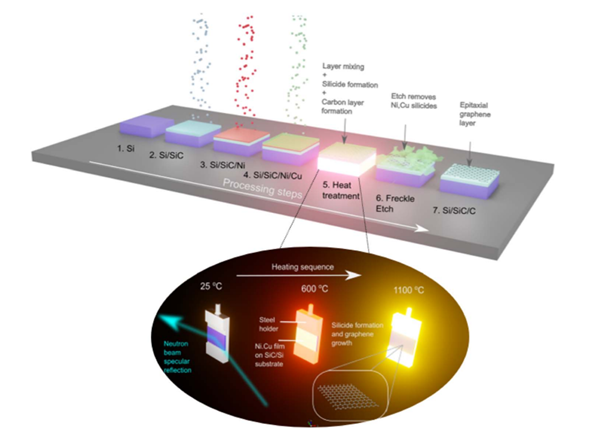A group of researchers from ANSTO and the University of Technology Sydney has broken previous records by using the Spatz reflectometer, which is outfitted with a vacuum furnace, to conduct thin-film experiments at 1100 ℃. The study has been published in RSC Advances.

Schematic of the Ni/Cu catalytic alloy-mediated EG synthesis on 3C–SiC on silicon. Image Credit: RSC Advances
Nucleon reflectometry and high-temperature equipment provide a unique combination that allows an atomic-scale understanding of thin-film growth and diffusion processes. This knowledge affects numerous thin-film technologies and gadgets that undergo various processing and heat-treatment procedures to maximize performance.
Under the direction of Francesca Iacopi and Aiswarya Pradeepkumar, the UTS group has been investigating the growth of graphene, or thin carbon sheets, on SiC/Si substrates at high temperatures. Highly conductive electronics that can be integrated with conventional silicon fabrication processes are made possible by this award-winning process.
The Australian Centre for Neutron Scattering's Spatz neutron reflectometer was heavily utilized by the UTS team to understand carbon growth mechanisms and onset temperatures better.
Neutron reflectometry allows the study of thin films with thicknesses ranging from 1 to 100 nm. Neutrons possess unique properties that allow for in-situ studies in sophisticated sample environments (a sophisticated vacuum furnace, in this case) to monitor changes in film over timescales ranging from minutes to hours.

Image Credit: MeshCube/Shutterstock.com
Dr. Aiswarya Pradeepkumar, a research fellow at the ARC Centre for Transformative Meta-optical Systems and recipient of the Australian Institute of Nuclear Science and Engineering (AINSE) Early Career Grant, led the ANSTO-UTS collaboration, the first experiment of its kind in Australia. This year, an article for Neutron News featured the research.
The unique high-temperature neutron reflectometry has allowed us to gain insights into the alloy-mediated epitaxial graphene synthesis on 3C-SiC/Si substrates unveiling novel avenues of 2D material optimisation for nanoelectronic and nanophotonic applications.
Dr. Aiswarya Pradeepkumar, ARC Centre for Transformative Meta-optical Systems
Two ANSTO scientists, Drs. David Cortie and Anton Le Brun made the research at ANSTO possible by integrating the furnace with Spatz.
The process was made possible by the fabrication of the unique sample holders and the integration of the furnace onto Spatz by the team from Scientific Operations and Neutron Scattering Sample Environment. Both were necessary for the experiments to be successful.
To the best of our knowledge, this is the highest temperature neutron reflectometry study that has ever been recorded, and it is a relatively unique capability internationally. It follows from some pioneering work done by Holt and colleagues at the ISIS Pulsed Neutron Source in England in the late 1990’s.
Dr. Anton Le Brun, ANSTO
In 2020, the Spatz instrument was transferred from HZB Berlin to the center and configured there. Due to its large open-plan design, the instrument can handle a variety of larger sample environments.
I am really excited by the new opportunities for high temperature reflectometry work. This capacity will allow a range of important thin film processes to be studied with neutron reflectometry for the first time, to reveal nanoscale insights that are hidden from many other probes. There are already a number of related thin film studies underway at the Australian Centre for Neutron Scattering.
Dr. David Cortie, ANSTO
Journal Reference:
Pradeepkumar, A., et al. (2024) Epitaxial graphene growth on cubic silicon carbide on silicon with high temperature neutron reflectometry: an operando study. RSC Advances. doi.org/10.1039/d3ra08289j